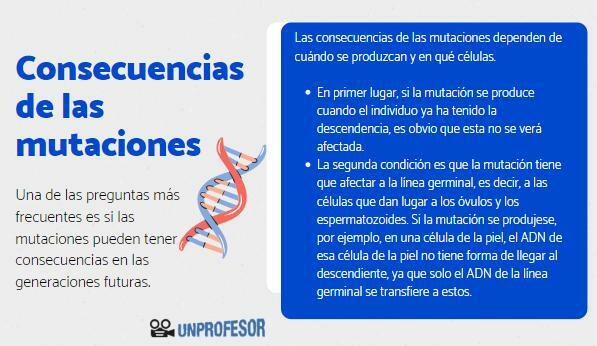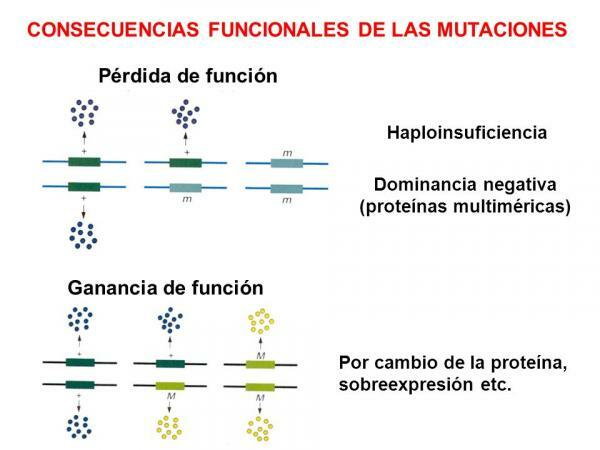Consequences of MUTATIONS

The genetic mutationss are all disturbance that occurs in the DNA sequence. Commonly, genetic mutations are related to diseases or adverse consequences for the body, but as we will see below, this is not always the case.
As we will see in this lesson, mutations can affect genetic material at different levels: they can have small-scale effects. scale (functional, for example) or large-scale effects (on an organism or its adaptive capacity within the ecosystem). If you want to know what the consequences of mutations, we invite you to continue reading this lesson from a TEACHER!
The mutationsare changes that alter nucleotide sequence that make up DNA. These mutations can affect a single nucleotide in the sequence (point mutations) or even entire chromosomes (chromosomal mutations). It must be borne in mind that the larger the region of the sequence affected or the more important it is, the greater effect it will have on the entire organism.
One of the most frequently asked questions is whether mutations can have consequences
in future generations. Well, the answer is clear, it depends on when they occur and in which cells.- In the first place, if the mutation occurs when the individual has already had the offspring, it is obvious that this will not be affected.
- The second condition is that the mutation has to affect the germ line, that is, the cells that give rise to eggs and sperm. If the mutation occurs, for example, in a skin cell, the DNA of that skin cell has no way of reaching the offspring as only germline DNA is transferred to these.
Bottom line: the consequences of mutations only manifest in the next generation when they occur before fertilization and affect germ cells.
In this lesson from a PROFESSOR we will focus on two of the main types of mutations according to their effects: functional mutations and adaptive mutations.

Image: Slideshare
Mutations with functional consequences are those that affect how the gene works, that is, the amount or variation of the protein encoded by the gene that has undergone the mutation. These mutations can be due to mutations in the same sequence of the gene or in sequences close to it, such as promoters.
The promoters are regions of DNA found just before the protein-coding sequences and act as conductors or foremen of a factory, is that is, they can "give orders" such as "do not produce", "produce a lot", "produce half" to the gene and, as a consequence, modify its functionality.
Within the functional mutations we can mainly find:
- Loss of function mutation. The mutated gene is inactivated, that is, it loses the ability to fully or partially perform its function.
- Gain of function mutation. Contrary to the previous one, the mutated gene has more expression than its original version. It may be that this gene produces more protein than its wild-type (unmutated) counterpart or that it is activated in situations where it should.
- Neomorphic mutations. In this case, the mutation of the gene leads to the production of a new protein, different from the one encoded by the normal version of the unmuted gene.
- Lethal mutations. On some occasions, the alteration of the original gene causes the death of the organism that suffers it and we are facing lethal alterations. They are alterations that occur in genes that are very important for development, and are behind many spontaneous abortions.

Image: Slideplayer
As we have seen so far, genetic mutations can produce variations in what, how and how much product genes synthesize. This may mean that an organism may be more or less prepared to adapt to the environment where it lives.
The ecosystem where we live is constantly changing, so the existence of genetic variability allows us, as a species, to be very prepared to adapt to these changes. It must be taken into account that a characteristic that gives us an advantage in certain conditions, can give us a disadvantage in another. These characteristics are called phenotypes, and they do not occur as an adaptation to changes in the environment, but rather that they were there before it occurred.
The consequences of adaptive or species level mutations They can be summarized in three types:
- Beneficial mutations. The modification of the original gene results in a phenotype that makes the individual who has it better adapted to the new conditions than the original organisms.
- Deleterious mutations. The alteration of a gene produces a characteristic that makes that individual worse adapted than the organism with the initial version of the gene.
- Neutral mutations. Finally, we find the mutations that do not produce harmful or beneficial effects in terms of the individual's ability to adapt. This is why they are called neutral mutations.
Neutral mutations continually occur in our DNA, which make us not better or worse adapted to current situations. It is when a change occurs, such as the appearance of a parasite, the alteration of the temperature, etc., that makes a neutral mutation become a beneficial or deleterious mutation.
